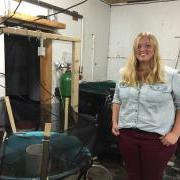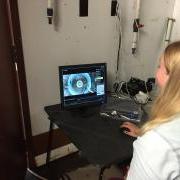Spying on salmon: Graduate student uses surveillance cameras to observe ecological interactions in a changing climate
NOTE: This blog was written by Nicole Ramberg-Pihl, a graduate student at the University of Maine, working on a Sea Grant-funded project with Dr. Hamish Greig, Dr. Stephen Coglan, and Dr. Joseph Zydlewski.
 Atlantic salmon have a vibrant history woven into that of Maine’s culture. After spending about one to three years in freshwater, they migrate to the ocean where they will spend another one to three years, all before returning to freshwater streams to spawn. Unfortunately, Atlantic salmon have faced several obstacles in their past which have caused their numbers to dwindle to a point where they are now listed as an Endangered Species. Among the list of threats that Atlantic salmon face is the ability to survive in a changing climate. This includes changes in stream temperatures and stream flow which can impact Atlantic salmon’s ability to survive or by a changing climate making it easier for competitors (such as Smallmouth bass) to invade new waters and possibly outcompete juvenile Atlantic salmon for space and resources in Maine streams. Our project is studying how these threats may be impacting juvenile Atlantic salmon during a critical time in their life history.
Atlantic salmon have a vibrant history woven into that of Maine’s culture. After spending about one to three years in freshwater, they migrate to the ocean where they will spend another one to three years, all before returning to freshwater streams to spawn. Unfortunately, Atlantic salmon have faced several obstacles in their past which have caused their numbers to dwindle to a point where they are now listed as an Endangered Species. Among the list of threats that Atlantic salmon face is the ability to survive in a changing climate. This includes changes in stream temperatures and stream flow which can impact Atlantic salmon’s ability to survive or by a changing climate making it easier for competitors (such as Smallmouth bass) to invade new waters and possibly outcompete juvenile Atlantic salmon for space and resources in Maine streams. Our project is studying how these threats may be impacting juvenile Atlantic salmon during a critical time in their life history.
Getting our lab space ready for experiments has been an exciting feat! We spent much of the summer building, plumbing, and troubleshooting the most effective way to research how these threats influence juvenile Atlantic salmon. We started by setting up our experimental tanks to resemble artificial stream environments and then progressed to a point where we could alter the temperature of the water, as well as how fast the water was flowing. We finished by installing a camera system which allows us to record how Atlantic salmon respond to different conditions when in the presence of competitors such as smallmouth bass. It was great to witness the transformation of our lab which began with an empty space, steadily build to a point where we can now collect data.

Perhaps one of the most beneficial aspects of being involved with this project is the level of support offered both by collaborators and the Aquaculture Center at UMaine, where our lab space for this project is currently located. While working through the logistics of this experiment, from planning out the floor space of the lab to manipulating temperature and flow in our artificial stream environments, I found that many people offered wonderful suggestions and even offered their time to help! I was also fortunate enough to have two great undergraduate students working with me to get everything up and running this summer.
In the past, my research has been based in ecology and animal behavior. My master’s research focused on the predator-prey relationship between the Northern crayfish, Orconectes virilis and Smallmouth bass, Micropterus dolomieu. I was interested in how the presence of predatory smallmouth bass influenced crayfish behavior and the resulting impacts to crayfish distribution in central New Hampshire Lakes. I was reading quite a bit about how the range expansion of predators could influence crayfish populations and how warming waters could be making it easier for predators to expand their range. This had me thinking about the larger scale issue of how our climate is changing, how it could be influencing the expansion of smallmouth bass (or other predators) into new waters, and what that meant for the overall dynamics of freshwater systems. This basis of thought has been helpful for the work that I am a part of today. The focus of our salmon project is similar to the broader ideas I started developing during my masters, in that we are examining the mechanisms of how climate change may be impacting freshwater species and the manner in which they interact with one another.
